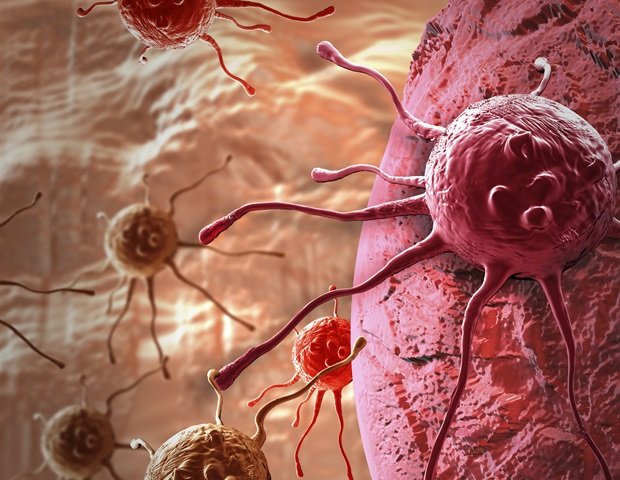A leading scientist whose discoveries about prostate cancer have led to life-saving treatments is now shedding light on an emerging and deadliest form of the disease: neuroendocrine prostate cancer (NEPC).
Most prostate cancers are classified as adenocarcinomas, which rely on a protein called the androgen receptor (AR) to survive and grow. Over the past decade, several effective AR-targeting drugs have become available. Physician-scientist Charles Sawyers, MD of Memorial Sloan Kettering Cancer Center (MSK), was instrumental in drawing attention to AR as a primary therapeutic target.
These drugs have saved many lives, but some people become resistant to AR treatments.
In recent years, Dr. Sawyers and colleagues at MSK made a surprising discovery about why this happens: prostate cancer cells can completely change their identity to escape the effects of AR-targeting drugs. This ability, known as lineage plasticity, allows prostate cancer cells to transform from adenocarcinoma to neuroendocrine prostate cancer, a much more aggressive and deadly form of the disease.
Cell shape change causes neuroendocrine prostate cancer to develop in 15% of patients receiving androgen receptor therapy. This makes NEPC the second most common type of this disease. And it’s especially deadly: The average survival rate for someone with neuroendocrine prostate cancer is only 18 months.
Now a team led by Dr. Sawyers has developed a powerful new research tool for understanding how this transition unfolds. The new platform makes it possible to observe the change in cellular states from the earliest stage, allowing researchers to tease apart the genetic mutations and cell-to-cell signals that are critical for lineage switching. It also helps shed light on the role played by surrounding cells, known as the tumor microenvironment.
“There is an urgent need to understand what drives this transformation in order to develop better treatments,” says Dr. Sawyers. “This new research platform enables us to identify the molecular factors involved in this transition at different stages.”
The ASCL1 protein helps with NEPC transition
Using this new tool, his team has already made a key discovery: The transition from adenocarcinoma to NEPC depends on a protein called ASCL1. Turning off the gene that makes this protein can prevent the transition.
But time is critical.
Delete it Ascl1 gene before initiation of transition can prevent adenocarcinoma from turning into NEPC. However, if the cancer has already become NEPC, disabling Ascl1 it will only cause the tumor to subside temporarily. The cancer comes back as many different histological variants, including an even more aggressive NEPC.
The results are reported in Nature Cancer.
This research suggests that ASCL1 is a good candidate as a drug target. But it also highlights the importance of early intervention in men with prostate cancer likely to become NEPC.”
Rodrigo Romero, PhD, researcher in the Sawyers lab and first author of the study
The new research platform gets answers faster
Previous research from the lab of Dr. Sawyer used a genetically engineered mouse model of prostate cancer. Dr. Romero says one limitation of these models is that they take time to create.
“If you’re interested in a gene like Ascl1to understand its operation you will need to create a strain with it Ascl1 He deleted the gene and crossed it with another strain, and then observed how that deletion affects the biology,” says Dr. Romero. “This could take months or even years.”
The new research platform provides answers much faster. Researchers take normal mouse prostate glands and grow them as organoids -? Three-dimensional structures composed of cells grouped and spatially arranged like an organ or tissue. Using a gene-editing technology called CRISPR, researchers can selectively delete specific genes in organoids and then transplant them into mice, which clarifies the role a given gene plays in both normal cell function and cancer development.
“We thought Ascl1 may be the key to the transition, but we needed strong evidence,” says Dr. Romero. “With this platform we were able to identify it as essential to the transformation in just three months.”
Research to develop ASCL1-targeted therapy for neuroendocrine prostate cancer
There are currently no drugs that target ASCL1. The protein is a transcription factor, which is involved in the process of transcribing DNA into RNA, the first step in gene expression.
“Transcription factors are notoriously difficult to make small molecule drugs,” says Dr. Romero. “But we’ve seen a lot of progress in targeting proteins that were once thought to be untreatable—like KRAS—and many groups are working to target transcription factors.”
In the future, the researchers plan to continue turning off other genes, one by one, to get a complete picture of which genes need to be turned on or off to cause the transition to NEPC. It is possible Ascl1 need to work with other genes -? or does it require signals from other cells in the tumor microenvironment -? before it goes into overdrive.
For example, researchers suspect a gene called Rb1 must be mutated to initiate ASCL1 plasticity, and perhaps other signals from the microenvironment are required. Clues to potential cooperating genes may emerge from a computational and systems biology approach taken in collaboration with the laboratory of computational biologist Dana Pe’er, PhD.
Elucidation of the different players will be essential to identify biomarkers that indicate which adenocarcinoma patients are at greater risk for prostate cancer transition to NEPC. If researchers can stratify patients into different risk groups, it would help guide clinical decisions.
“If we follow patients while they are on treatment, it may eventually make sense to switch higher-risk patients from AR drugs to a more targeted neuroendocrine therapy,” says Dr. Romero. “But we need to develop a much more comprehensive data set to get a clearer picture of what’s driving the transformation. This research platform allows us to get those answers much faster.”
Source:
Journal Reference:
Romero, R., et al. (2024). The neuroendocrine transition in prostate cancer is dynamic and dependent on ASCL1. Nature Cancer. doi.org/10.1038/s43018-024-00838-6.
